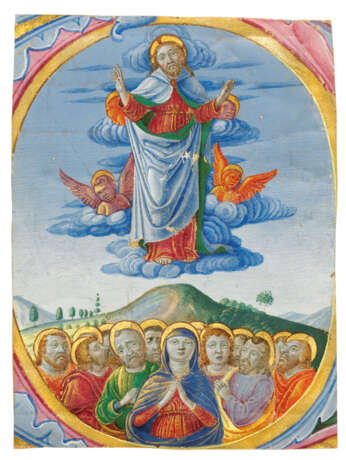ID 470130
Lot 32 | Domenico Morone (c1442-1503)
Estimate value
£ 8 000 – 12 000
The Ascension of Christ, Verona, c.1500
THE ASCENSION OF CHRIST, historiated initial on vellum cut from a choirbook illuminated by Domenico Morone [Verona, c.1500].
A rare work of illumination by the pioneering Renaissance panel painter and frescoist Domenico Morone (c.1442-1503).
127 x 95mm. Historiated initial 'O' with the Ascension of Christ, reverse with fragment of text and music on a red stave (trimmed close to the edge of the miniature, a few small losses of pigment to Christ's robe and the hill in the background). Provenance: (1) The surviving cuttings associated with this miniature were all likely taken from a Franciscan gradual (the iconography of two of the cuttings indicates a Franciscan context). The majority of these cuttings were reunited by Hans-Joachim Eberhardt in 'Nuovi studi su Domenico Morone, Girolamo dai Libri e Liberale', Miniatura Veronese del Rinascimento, exh. cat., 1986, pp. 103-161. (2) Paul Graupe, Berlin sale 76, 12 December 1927, lot 50 (described as school of Mantegna) to: (3) Kurt Arnhold (1887-1951), Dresden bank and collector. (4) Sotheby’s, 23 June 1992, lot 20. (5) Maggs, European Bulletin 19, 1994, no 23.
Strongly influenced by Mantegna and Squarcione, Domenico Morone was one of the leading Veronese painters of his time. Among Domenico's earliest surviving recorded works is a Madonna and Child (Berlin, Gemäldegal.) signed and dated in 1483. Mantegna's influence is evident in this piece, and Domenico almost certainly came into contact with a Mantegnesque style through the art of Francesco Benaglio, considered to be Domenico's teacher. Throughout the 1490s Domenico led a large workshop which was involved in many great commissions including the fresco cycle for the library of San Bernardino in Verona; in this work he blended his own powers of observation with Mantegnesque spatial effects and decorative motifs. His activity as an illuminator has only relatively recently been explored, largely thanks to Hans-Joachim Eberhardt's catalogue of a 1986 exhibition of Veronese Renaissance illumination. Morone's hard, linear style, sculpturesque figures, plastic manner of rendering drapery, and rocky landscape are all evident in the present cutting. Gaudenz Freuler sees Morone as a nostalgic, classicising artist who, while paying tribute to Liberale da Verona, follows a distinct artistic path; his style more rooted in the work of the artists active at the Este court, such as Martino da Modena and Jacopo di Filippo Argenta, than of his Veronese contemporaries (see G. Freuler, Italian Miniatures, 2013, II, pp.788-95).
Freuler has assembled an updated list of surviving miniatures attributable to Domenico Morone, among which we should add the present cutting (G. Freuler, Italian Miniatures, II, pp.790-2). Sister-cuttings are in Berlin (Kupferstichkabinett, 629), New York (Metropolitan Museum of Art, Robert Lehman Collection, 1975.1.2483), Philadelphia (Free Library, Lewis 45:28), and London (Victoria and Albert Museum, inv.4916 and 4924, plus a further nine foliate initials).
| Genre: | Religious genre |
|---|
| Genre: | Religious genre |
|---|
| Address of auction |
CHRISTIE'S 8 King Street, St. James's SW1Y 6QT London United Kingdom | |
|---|---|---|
| Preview |
| |
| Phone | +44 (0)20 7839 9060 | |
| Buyer Premium | see on Website | |
| Conditions of purchase | Conditions of purchase |



